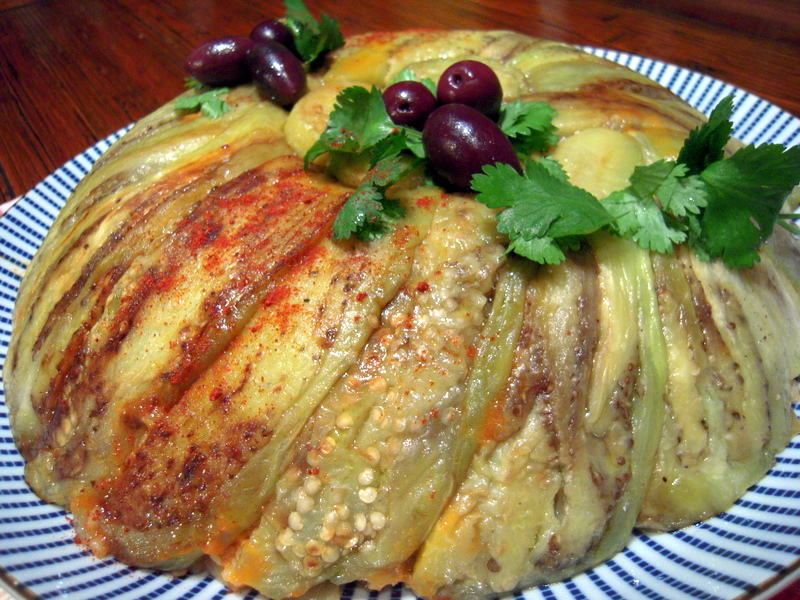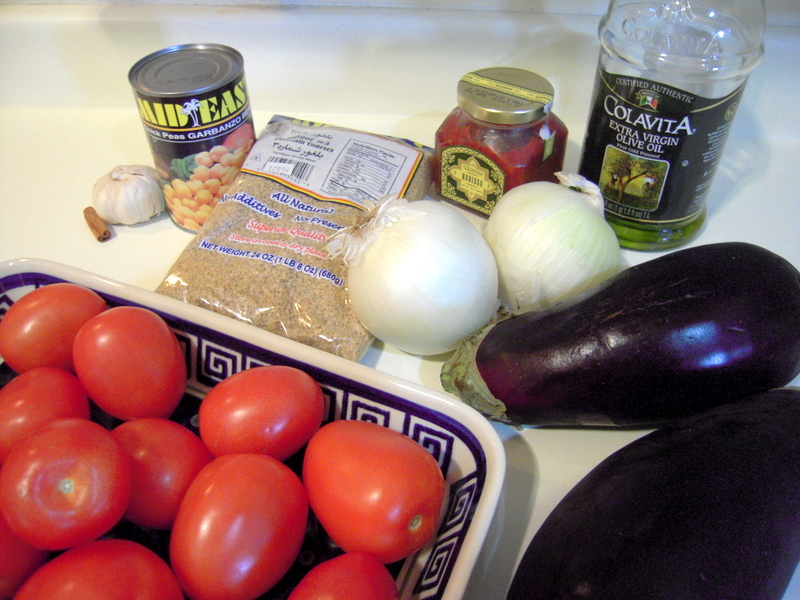We at weirdcombinations have become big fans of Taste of Beirut (which I’ll abbreviate as “ToB” here). Many of the exciting recipes on that blog offer delicious vegetarian options and creative uses of seasonal ingredients all presented in an accessible and personal style that we really enjoy. Last week I saw the ToB post for “eggplant, bulgur and tomato casserole” and decided to try the recipe myself.
This one appealed to me in particular because the ingredients themselves aren’t that complex and I’m always curious about new ways of preparing bulgur. Of course, I didn’t follow Joumana’s recipe perfectly as I didn’t quite have all the right things. For instance, she recommends coarse bulgur #4 but I only had coarse bulgur #3. (I’ve been wondering about that, Joumana. What are the differences between the various sizes of bulgur and how might an inexperienced cook decide which to use if it isn’t clear from the recipe?)
This recipe calls for dashes of cinnamon and allspice, which I didn’t have. Instead I used a small stick of cinnamon and a whole “ball” of allspice which I removed after simmering the tomato sauce. I made my own vegetable stock with carrot and onion. Finally, as an optional step, the ToB master recipe recommends tomato paste or red pepper paste. I used some spicy Harissa sauce which I had on hand and felt was in the spirit of the dish.
I was worried about flipping the casserole out of the dish at the end but it was really easy. The eggplant becomes a vegetable covering, almost like a soft crust over the filling. It was stunning to look at the finished casserole and it tasted wonderfully. I encourage you to try this and to check out Taste of Beirut.
Taste of Beirut style Eggplant Tomato Bulgur Casserole without the Dish
2 large eggplants
Olive oil as needed
2 large onions
4 cloves garlic
1½ lbs. tomatoes, peeled and diced
1 can garbanzo beans, rinsed
1½ cups coarse bulgur
2 to 3 cups vegetable stock
1 tsp. Harissa sauce
1 small cinnamon stick or a dash of powdered
1 whole allspice “ball” or a dash of powdered
Kosher salt and fresh black pepper
Kalamata olives, cilantro and dash of paprika as garnish
Rinse bulgur and soak in a large bowl of water for thirty minutes.
While bulgur soaks, peel eggplant and cut into slices. Mine were about ½ inch thick but shrank a lot during preparation. I cut a few rounds and the rest as long strips as I wanted to try for a flower design for the final presentation. Once the eggplant is sliced, toss with salt and allow to rest in a colander for thirty minutes or so.
Immediately begin the tomato sauce once bulgur and eggplant are resting.
Chop onions and sauté in a few tablespoons olive oil until they become golden and a bit translucent (about 5 minutes). Add diced tomatoes, some salt to taste, the cinnamon and allspice. Simmer for about thirty minutes, covered, stirring occasionally.
After the sauce has had time to simmer, add mashed garlic, Harissa sauce, rinsed soaked bulgur and vegetable stock. I removed the cinnamon stick and allspice at this point. Cook covered for about twenty minutes or until bulgur is cooked. Adjust salt and add more vegetable stock if needed (I used about 2½ cups stock).
While bulgur cooks, rinse eggplant slices and fry in olive oil until they become soft. Remove to a platter covered with paper towels. Dab off excess olive oil. Season with salt and black pepper.
To assemble the dish, begin by covering the interior of a large bowl with cling film. Then arrange eggplant slices over inner surface of bowl in an attractive pattern. Gently pour tomato bulgur filling over eggplant slices to the rim of the bowl. I had a bit extra filling which I kept aside. Allow to rest to let bulgur cool a little and “set.”
To serve, invert a large serving dish over bulgur. Holding the dish firmly over the bowl, flip the platter and bowl. Remove bowl and cling film. Garnish with cilantro, olives and a dash of paprika.
Thanks for the amazing recipe, Joumana!


Comments on this entry are closed.
WOW! Stevie! I am stunned!
This is beautiful!
Love how you interpreted the dish too! The beauty of Lebanese cuisine is it gives a lot of latitude and one can be creative.
The dome looks so perfect one looks at it and wants to devour what’s inside.
I am so impressed!
RE: Bulgur; the rule of thumb is coarse is used for casseroles, stuffing vegetables (swiss chard, cabbage, vine, etc) and the fine bulgur #1 is used for making the kibbeh and the tabbooleh salad.
In Lebanon they even have an extra-fine one, almost like flour, that they used when they make vegetarian kibbeh.
Joumana
I’m so glad that you approve! One never knows what the original cook might think when trying out their recipe.
Thanks for your info about the various kinds of bulgur. Heguiberto is anxious to make a vegetarian kibbeh. A version with beef is very popular in Brazil but when we visited earlier this year, our friends made a vegi one. Yum! Do you have a version that you like? I’ve read about one in Silk Road Cooking, that book that I’ve become preoccupied with lately, but since I haven’t made it I’m not sure.
Stevie